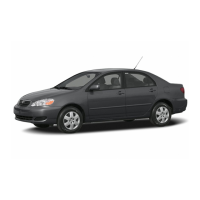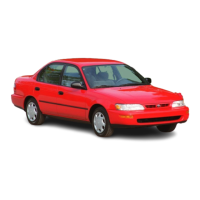270
4-5. Using the driving support systems
If a sensor is dirty, the position of the
dirty sensor will be shown on the
display.
Also, due to ice forming on a sensor
at low temperatures, a warning
message may be displayed or the
sensor may not be able to detect an
object. Once the ice melts, the sys-
tem will return to normal.
If a warning message is displayed
even if the sensor is clean, there
may be a sensor malfunction. Have
the vehicle inspected by your Toyota
dealer.
■ Sensor detection information
● The sensors may be able to only
detect objects near the front and
rear bumpers.
● The following situations may occur
during use.
• Depending on the shape of the
object and other factors, the
detection distance may shorten, or
detection may be impossible.
• Detection may be impossible if
static objects draw too close to the
sensor.
• After the static object detection,
there will be a short delay before a
graphic is shown on displays, and
warning buzzer sounds. Even at
low speeds, there is a possibility
that the object will come within the
sensor’s detection areas before
the display is shown and the warn-
ing beep sounds.
• It might be difficult to hear the
buzzer due to the volume of the
audio system or air flow noise of
the air conditioning system.
• It may be difficult to hear the
buzzer if buzzers for other sys-
tems are sounding.
■ Objects which the system may
not be properly detected
The shape of the object may pre-
vent the sensor from detecting it.
Pay particular attention to the follow-
ing objects:
● Wires, fences, ropes, etc.
● Cotton, snow and other materials
that absorb sound waves
● Sharply-angled objects
● Low objects
● Tall objects with upper sections
projecting outwards in the direc-
tion of your vehicle
● People may not be detected if
they are wearing certain types of
clothing.
■ Situations in which the system
may not operate properly
Certain vehicle conditions and the
surrounding environment may affect
the ability of a sensor to correctly
detect objects. Particular instances
where this may occur are listed
below.
● There is dirt, snow, water drops or
ice on a sensor. (Cleaning the
sensors will resolve this problem.)
● A sensor is frozen. (Thawing the
area will resolve this problem.)
In especially cold weather, if a
sensor is frozen the sensor dis-
play may be displayed abnormally,
or objects, such as a wall, may not
be detected.
● When a sensor or the area around
a sensor is extremely hot or cold.
● On an extremely bumpy road, on
an incline, on gravel, or on grass.
● When vehicle horns, vehicle
detectors, motorcycle engines, air
brakes of large vehicles, the clear-
ance sonar of other vehicles or
other devices which produce ultra-
sonic waves are near the vehicle
● A sensor is coated with a sheet of
spray or heavy rain.

